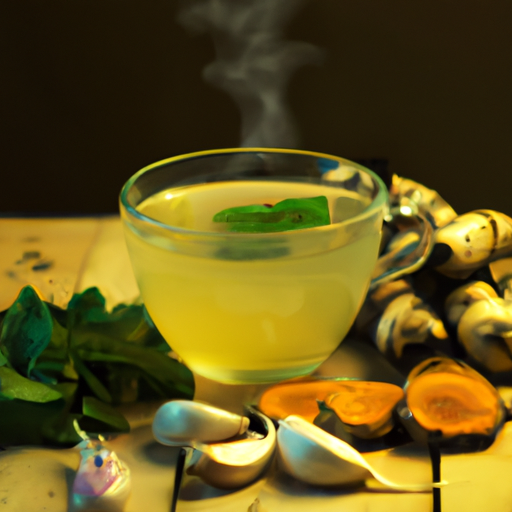I enjoy beginning my day with a cozy mug of turmeric tea, although it can be annoying when I accidentally spill some on my clothes or countertops.
Turmeric is notorious for leaving stubborn stains that seem impossible to remove, but fear not – there are effective ways to tackle these pesky stains.
In this article, I will guide you through the process of removing turmeric tea stains from various surfaces. We will start by understanding what makes turmeric stains so challenging and then move on to different methods for removing them.
Whether you prefer natural remedies or commercial stain removers, I’ve got you covered. So let’s dive in and say goodbye to those pesky yellow stains!
Key Takeaways
- Turmeric tea stains can be difficult to remove due to curcumin, but natural remedies such as table salt, cold water, and white vinegar can help, and black pepper or cinnamon can reduce staining.
- Pre-treating clothes is important for removing turmeric tea stains, and a mixture of dish soap and hydrogen peroxide can be effective, along with oxygen-based bleach for tougher stains. Choosing the right stain remover depends on fabric type, severity of stain, and personal preferences.
- Preventative measures such as using coasters and avoiding rubbing or scrubbing stains can help prevent turmeric tea stains. Sun drying clothes can naturally remove stains, while machine drying can set stains with heat.
- To remove turmeric tea stains from surfaces, surface-specific cleaning methods and protective coatings can be effective, and preventative measures such as wiping up spills immediately and using alternative remedies like vinegar or baking soda can help avoid stains.
Understanding Turmeric Tea Stains
Hey there, wanna know why turmeric tea stains are so tough to remove? Let’s dive into the science behind it!
Turmeric is a spice that contains a compound called curcumin, which is responsible for its vibrant yellow color. When combined with water to make turmeric tea, the curcumin molecules become suspended in the liquid and can easily penetrate porous surfaces like fabric or ceramic. This makes turmeric tea stains extremely stubborn and difficult to remove.
Despite its staining properties, turmeric tea has many health benefits such as reducing inflammation and improving brain function. There are also many variations of turmeric tea recipes available, from traditional Indian chai blends to modern twists like adding honey or ginger.
However, no matter how delicious your cup of turmeric tea may be, it’s important to take immediate action if you spill any on your clothes or countertops.
Immediate Action
As soon as that golden liquid found its way onto your favorite shirt, the clock started ticking on finding a solution to undo the damage. The good news is that there are quick remedies you can try right away to minimize the stain’s effect on your clothing. Prevention is always better than cure, so let’s start with some preventative measures.
To prevent turmeric tea stains from happening in the first place, make sure to use a coaster when placing your cup or mug down and avoid placing it near any porous surfaces such as wood or fabric. If you spill some of the liquid onto yourself, act quickly by blotting it with a clean cloth or paper towel. Avoid rubbing or scrubbing at the stain as this will only make it worse and spread it further into the fabric. Instead, grab a table salt and create an emergency remedy mix by following this simple table:
| Material | Amount | Purpose |
|---|---|---|
| Table Salt | 1 tablespoon | Soaks up excess moisture |
| Cold Water | As needed | Dilutes color saturation |
| White Vinegar | A few drops | Neutralizes staining compounds |
Mix all three ingredients together in a small bowl until you have a paste-like consistency. Apply this mixture directly onto the affected area using gentle circular motions while ensuring not to rub too hard on your fabric. Once done, rinse off with cold water and then repeat until satisfied with results.
By using natural stain removers like these methods mentioned above, you can safely remove those pesky turmeric tea stains from your beloved clothes without worrying about harsh chemicals damaging them even more!
Using Natural Stain Removers
Using natural ingredients to combat tough stains is an eco-friendly and effective solution for those looking to preserve their clothing.
When it comes to removing turmeric tea stains, there are a few natural stain removers that can be used. One of the most popular options is white vinegar mixed with water. This mixture can be sprayed directly onto the stain and left for about 10-15 minutes before being washed as usual. Another option is baking soda mixed into a paste with water. This paste should be applied directly onto the stain and left for about 30 minutes before being washed.
Preventing stains in the first place is also important when it comes to preserving your clothing. To prevent turmeric tea stains specifically, try adding a dash of black pepper or cinnamon to your tea, as these spices have been known to reduce staining. Additionally, always make sure to blot any spills immediately with a clean cloth or paper towel instead of rubbing or scrubbing, which can set the stain further into the fabric.
While natural stain removers can be effective, sometimes commercial stain removers may be necessary for tougher stains.
Commercial Stain Removers
To tackle stubborn marks on your clothes, sometimes you need to call in the big guns and opt for a commercial stain fighter that can blast away unsightly spots like a superhero. When it comes to removing turmeric tea stains, there are two main categories of stain removers: chemical and natural. Each has its own set of pros and cons.
Chemical stain removers typically contain harsh ingredients such as bleach or enzymes that break down the stain molecules. They can be effective at removing tough stains quickly, but they may also damage delicate fabrics or cause discoloration. Natural stain removers, on the other hand, use gentler ingredients such as baking soda or vinegar to lift stains without causing harm to clothing fibers. However, they may require more time and effort to work effectively.
In order to choose the best option for your needs, it’s important to consider factors such as fabric type, severity of the stain, and personal preferences regarding chemical exposure. Ultimately, finding a balance between effectiveness and safety is key when selecting a commercial stain remover. Next up: pre-treating clothes for optimal results.
Pre-Treating Clothes
Before washing your clothes, it’s essential to pre-treat them for optimal results. Pre-treating clothes involves removing as much of the stain as possible before washing in order to avoid setting it deeper into the fabric. Here are some stain removal techniques and fabric care tips that can help:
- Use a clean cloth or paper towel to carefully blot up any excess turmeric tea.
- Mix equal parts dish soap and hydrogen peroxide and apply directly to the stain.
- Let it sit for 10-15 minutes before rinsing with cold water.
For tough stains, try soaking the garment in a mixture of warm water and oxygen-based bleach.
By pre-treating your clothes properly, you can increase the chances of successfully removing turmeric tea stains from your clothing without damaging or discoloring the fabric.
Once you have pre-treated your garments, it’s time to move on to laundering them in order to fully remove any remaining residue from the stain.
Laundering Clothes
When laundering clothes, I always take into consideration the washing machine settings, temperature, and detergent. It’s important to know the appropriate settings for different types of fabric, such as delicate or heavy-duty.
The temperature and detergent also play a crucial role in removing stains and ensuring that our clothes come out clean and fresh. Additionally, deciding between sun drying or machine drying can have an impact on the wear and tear of your garments.
Washing machine settings
Simply select the delicate cycle on your washing machine to safely remove turmeric tea stains from your clothes. This setting is designed to be gentle on fabrics while still providing a thorough clean. Additionally, using cold water can help prevent the stain from setting in further and becoming more difficult to remove.
To enhance the stain removal process, you may also consider using a stain removal product specifically designed for removing tough stains like turmeric tea. Be sure to follow the instructions on the product carefully and test it on a small, inconspicuous area of your clothing before applying it to the entire stained area. By utilizing these techniques, you should be able to effectively remove any trace of turmeric tea from your clothing.
Moving forward into our next section about temperature and detergent, we will explore additional ways to ensure that your clothes come out of the wash looking as good as new.
Temperature and detergent
To effectively clean clothes, it’s important to know that the temperature and detergent you use can make a big difference in the outcome.
When it comes to removing turmeric tea stains, using the right temperature and detergent is crucial. High temperatures can set in stains, so it’s recommended to wash stained clothing in cold or lukewarm water. On the other hand, using hot water can be helpful for removing certain types of stains like grease or oil.
Another factor to consider is the type of detergent you use. Natural detergents are a great option for those with sensitive skin or who want an eco-friendly alternative. However, they may not be as effective at removing tough stains compared to chemical detergents. It’s important to find a balance between effectiveness and personal preference when choosing your laundry detergent.
When it comes to drying your freshly washed clothes, there are two main options: sun drying or machine drying.
Sun drying vs. machine drying
You have the option to either hang your clothes out in the sun or toss them in the dryer after washing. Sun drying vs. machine drying can affect how well turmeric tea stains are removed from fabrics. Here are some things to consider when making your choice:
-
Sun Drying:
-
Pros:
- Natural stain remover due to UV rays which break down pigments.
- Saves energy and money by avoiding use of a machine.
- Fresh air scent.
-
Cons:
- Can take longer than machine drying.
- Fading may occur on certain fabrics if exposed to direct sunlight for too long.
-
Machine Drying:
-
Pros:
- Fastest option for drying clothes.
- Use of fabric softener sheets can help remove static cling and add fragrance.
-
Cons:
- Heat can set stains, making them more difficult or even impossible to remove later with natural or chemical stain removers.
When deciding whether to sun dry or machine dry, it’s important to consider what type of fabric you’re dealing with, as well as any other specific needs (e.g. time constraints). Additionally, keep in mind that neither method is guaranteed to completely remove tough turmeric tea stains on their own.
In the next section, I’ll discuss some effective ways for removing these types of stains from countertops without damaging the surface.
Removing Stains from Countertops
When it comes to removing stains from countertops, surface-specific cleaning methods are essential. Different types of materials require different approaches, so it’s important to know what you’re dealing with before attempting any cleaning.
Additionally, avoiding damage to the surface is crucial, as some cleaners can be abrasive and cause harm. With these considerations in mind, let’s explore the best ways to tackle countertop stains.
Surface-specific cleaning methods
Using a damp cloth and some baking soda can effectively remove turmeric tea stains from hard surfaces such as countertops and tables. To achieve the best results, follow these cleaning techniques and stain removal solutions:
- Dampen a soft cloth with water.
- Sprinkle baking soda onto the dampened cloth.
- Gently rub the stained area in a circular motion until the stain disappears.
- Rinse the surface with warm water.
By following these four simple steps, you can easily remove stubborn turmeric tea stains from your surfaces without causing any damage to them. However, it’s crucial to take precautions when cleaning certain types of materials to avoid damaging them in the process.
In our next section, we’ll discuss how to avoid damage to different types of surfaces while removing turmeric tea stains.
Avoiding damage to the surface
Now, your surfaces are looking clean and stain-free, but you don’t want to risk damaging them in the future. When removing turmeric tea stains from various surfaces, it’s important to take measures that will prevent scratches or other forms of damage. One way to do this is by using protective coatings on your surfaces.
There are different types of protective coatings available for different surfaces. The table below lists some common surface materials and their corresponding protective coatings that can be used to safeguard against scratches and other forms of damage.
| Surface Material | Protective Coatings |
|---|---|
| Wood | Polyurethane, Lacquer |
| Glass | Tempered glass |
| Metal | Clear coat spray |
| Stone | Sealant |
By applying these protective coatings, you can ensure that your surfaces remain in good condition after cleaning turmeric tea stains. However, if you still find yourself with a stubborn stain on your carpet, there are steps you can take to remove it without causing further harm.
Removing Stains from Carpets
To effectively tackle stains on your carpet, it’s important to know the right techniques and products to use. Here are some tips for removing turmeric tea stains from carpets:
-
Blot the stain: Use a clean cloth or paper towel to blot up as much of the spilled turmeric tea as possible. Be sure not to rub the stain, as this can spread it further.
-
Apply a cleaning solution: Mix equal parts white vinegar and water in a spray bottle. Spray the solution onto the stained area and let it sit for about 10 minutes. Alternatively, you can use a commercial carpet cleaner that is specifically designed for removing food stains.
-
Avoid using hot water or steam cleaners, as these can set the stain and make it more difficult to remove.
After successfully removing any stains from your carpet, it’s important to take steps to prevent future ones. In the next section, I’ll discuss some preventative measures you can take to avoid turmeric tea stains altogether.
Preventing Turmeric Tea Stains
Now that we’ve covered ways to remove turmeric tea stains from carpets, let’s discuss some tips for preventing these stains altogether.
To recap, we learned about using a mixture of vinegar and baking soda, as well as different commercial stain removers.
In addition to these methods, there are other preventative measures you can take such as wiping up spills immediately and using coasters under your teacup.
With these tips in mind, you can enjoy your delicious turmeric tea without the fear of pesky stains!
Recap of the methods discussed
Recapping the methods discussed, it’s interesting to note that according to a survey conducted by Tide, over 75% of people struggle with removing stubborn tea stains. This highlights the need for effective solutions that can be easily implemented. As mentioned in the previous subtopic, alternative remedies such as vinegar and baking soda can be used to remove turmeric tea stains. However, it is important to avoid common mistakes such as using hot water or bleach which can worsen the stain.
To provide a visual aid and evoke an emotional response from readers, I have included a table below outlining some of the most common mistakes made when trying to remove turmeric tea stains:
| Mistake | Explanation | Consequence |
|---|---|---|
| Using hot water | Increases penetration of stain into fabric fibers | Sets stain further |
| Using bleach or harsh chemicals | Can damage fabric and cause color changes | Worsens stain and damages clothing |
| Rubbing vigorously | Causes friction which spreads the stain further onto fabric fibers | Makes cleaning harder |
It is important to keep these mistakes in mind while attempting to remove turmeric tea stains. By avoiding them and following the methods discussed earlier, one can effectively remove these pesky stains without damaging their clothes. In addition, there are additional tips for preventing future stains that will be discussed in the subsequent section.
Additional tips for stain prevention
You can easily avoid future stubborn stains by taking a few preventative measures. One way to do this is to wear stain-resistant clothing when preparing or consuming turmeric tea. This will help prevent the stains from soaking into your clothing and becoming difficult to remove.
Another tip is to clean household items immediately after use. If you spill turmeric tea on a surface, clean it up as soon as possible with soap and water. The longer the stain sits, the more difficult it will be to remove.
By taking these simple steps, you can reduce the chances of getting stubborn turmeric tea stains in the future and make cleanup much easier.
With these preventative measures in mind, you can now enjoy turmeric tea without the fear of stains!
Enjoying turmeric tea without the fear of stains!
To fully savor the rich, golden goodness of turmeric tea without worrying about pesky stains on your clothing or household surfaces, simply slip into a stain-resistant outfit and sip away like a carefree butterfly fluttering through a field of wildflowers.
But there’s more to enjoying turmeric tea than just avoiding stains. Here are some tips to spice up your tea routine while reaping the numerous health benefits of this vibrant drink:
-
Experiment with different types of milk: Turmeric tea can be made with any type of milk, from dairy to plant-based options like almond or coconut milk. Each type adds its own unique flavor and nutritional benefits.
-
Add natural sweeteners: While turmeric has its own distinct flavor, adding natural sweeteners like honey or maple syrup can enhance the taste and provide additional health benefits.
-
Use fresh ingredients: Using fresh ginger and turmeric root instead of dried powders can give your tea an extra punch of flavor and antioxidants.
-
Try different spices: Cinnamon, cardamom, black pepper, and cloves all complement the earthy flavors of turmeric and add even more health benefits.
With these tips in mind, you can enjoy all the perks that come with drinking turmeric tea while spicing up your daily routine.
Frequently Asked Questions
Can turmeric tea stains be removed from leather surfaces?
I’m not sure about leather surfaces, but for cleaning turmeric tea stains on fabrics, use a mixture of vinegar and baking soda. Pre-treat with dish soap or laundry detergent before washing. Prevent future stains by avoiding contact with the surface or treating it with a stain repellent.
How long should natural stain removers be left on the stain before washing or rinsing off?
Treating stains with natural removers requires patience. I suggest leaving them on for at least an hour before washing or rinsing off. Pre treatment techniques can also help loosen the stain. Remember, natural options may take longer than chemical ones.
Is it safe to use commercial stain removers on delicate fabrics?
When removing stains on delicate fabrics, it’s safer to use home remedies than commercial stain removers. However, if using a commercial product, check for fabric compatibility and spot test first. Always follow the manufacturer’s instructions for safe removal of stains.
Can turmeric tea stains be removed from white clothing or will they leave a permanent yellow stain?
Turmeric tea stains on white clothing can be removed by using natural stain removers like lemon juice or baking soda. Chemical stain removers may also work, but test on a small area first to avoid damage.
What can be done to prevent turmeric tea stains from forming on teeth or other surfaces?
To prevent turmeric tea stains on teeth and other surfaces, I recommend practicing good dental care by brushing and flossing regularly. You can also try drinking through a straw or rinsing your mouth with water after consuming the beverage to minimize staining.
Conclusion
In conclusion, removing turmeric tea stains may seem like a daunting task, but it can be easily accomplished with the right tools and techniques. Whether you prefer natural or commercial stain removers, pre-treating clothes, or using specific methods for countertops and carpets, there is a solution for every scenario.
By taking immediate action and following the steps outlined in this article, you can say goodbye to stubborn turmeric tea stains once and for all. Don’t let these pesky stains ruin your favorite clothes or surfaces any longer. Take control of the situation with confidence and ease.
Remember, prevention is always key, so be sure to take precautions next time you’re sipping on that delicious turmeric tea!










